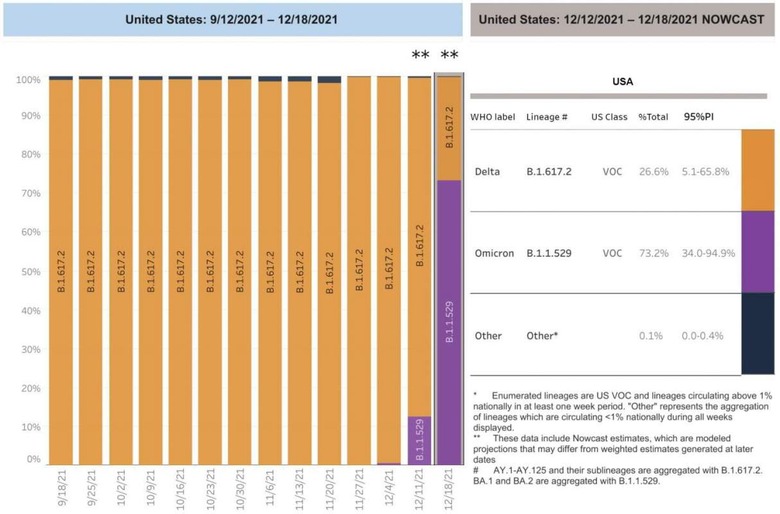CDC says COVID-19 variant Omicron is already dominant in the US
The SARS-CoV-2 virus has mutated over the past couple of years, with some mutations fading away fairly quickly and others leading to the rise of new "variants of concern." The CDC monitors these variants through genomic sequencing and regularly updates data on which strains are circulating in the US. The health agency updated its tracker with the latest data this week, revealing the omicron variant is now responsible for more COVID-19 cases than delta.
Omicron overtakes delta in US
Public health officials have been warning for a year now that as many people as possible need to be vaccinated against SARS-CoV-2 as quickly as possible to prevent potentially damning mutations. A number of these mutations have popped up throughout the pandemic, some relatively isolated and short-lived, others widespread and concerning. Delta has long been the dominant variant in the US, fueling waves of cases due to its higher transmission rate compared to the original version of the virus.
Whereas the delta variant (also called B.1.617.2) was first identified in India, the far newer omicron variant (B1.1.529) was first spotted in South Africa. At this time, WHO and the CDC state that omicron may have a higher transmission rate than delta, meaning it may spread more easily and, as a result, cause new waves of infections. Due to the particular mutations found in this variant, public health agencies also expect that omicron can lead to breakthrough infections in people who are already vaccinated, though the current vaccines still offer protection against severe outcomes like hospitalization and death.

On Monday, the US Centers for Disease Control and Prevention updated its COVID-19 variant tracker with the latest data as of December 18. The update reveals the majority of new COVID-19 infections in the US are now the result of the omicron variant rather than delta, the latter of which was dominant for months.
The graph shows very few omicron cases in the US as of December 4 at only 0.7-percent, followed by a big jump to 12.6-percent by December 11. That percentage has skyrocketed in only a week, hitting approximately 73-percent of cases by December 18. The data is made possible, in part, by the CDC's genomic surveillance of the virus, which tests COVID-19 samples; the resulting data is used with the Nowcast model to estimate how many cases in the US are caused by each variant. Nowcast estimates, the agency notes, help state and federal government officials quickly implement new public health measures when necessary.
What we know so far
Unfortunately, there's still a lot we don't know about the omicron variant, which was only labeled a variant of concern by the World Health Organization in late November. The mutation was found in samples from South Africa and Botswana only days ahead of the designation; the first omicron case in the US was identified on December 1, only a couple of days after the government made its own variant of concern designation (via CDC).
Public health agencies and pharmaceutical companies have been quick to analyze the variant, discovering mutations that raise some concerns over potentially high transmission rates and decreased vaccine efficacy. The variant popped up right around the same time the US made booster shots available to adults, and, fortunately, early data shows these booster doses help protect against omicron.

